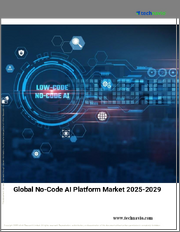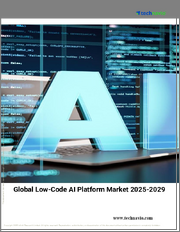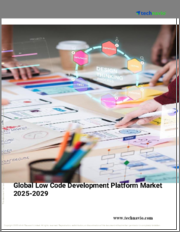
|
시장보고서
상품코드
1662620
세계의 노코드 AI 플랫폼 시장(-2030년) : 컴포넌트 유형별, 사용자 유형별, 전개 모드별, 용도별, 최종 사용자별, 지역별 예측 및 분석No-Code AI Platforms Market Forecasts to 2030 - Global Analysis By Component Type (Platform and Services), User Type, Deployment Mode, Application, End User and By Geography |
||||||
Stratistics MRC에 따르면 세계 노코드 AI 플랫폼 시장은 2024년 50억 달러를 달성하였고 예측 기간 동안 CAGR은 31.6%로 성장하여 2030년에는 261억 달러에 이를 것으로 예측됩니다.
사용자가 프로그래밍 지식을 필요로 하지 않고 인공지능 모델을 작성, 구현 및 유지할 수 있는 플랫폼과 기술은 "노코드 AI"로 알려져 있습니다. 이러한 플랫폼은 드래그 앤 드롭 기능과 사전 구축된 템플릿이 포함된 비주얼 인터페이스를 제공하여 비기술 사용자가 자동화, 예측 분석, 데이터 처리 등의 작업을 위한 AI 솔루션을 만들 수 있도록 합니다. 노코드 AI는 인공지능을 보다 친숙하게 하여 기업이나 개인이 깊은 프로그래밍 지식을 필요로 하지 않고 AI의 능력을 활용할 수 있도록 합니다.
산업 전문가에 따르면 2025년까지 새로운 기업 앱의 70%가 로우코드 플랫폼 또는 노코드 플랫폼을 채택할 것으로 보이며, 이는 기술 산업에서 자동화와 비용 효율성으로의 전환이 진행되고 있음을 보여줍니다.
AI 솔루션에 대한 수요 증가
기업이 전문 개발자에 의존하지 않고 첨단 기술을 통합하려고 노력함에 따라 시장에서 AI 솔루션에 대한 수요가 증가하고 있습니다. 기업은 자동화, 데이터 분석 및 고객 서비스를 위해 효율성과 의사결정을 개선하는 AI 기반 도구를 찾고 있습니다. 노코드 플랫폼은 AI를 구현할 수 있는 접근 가능한 방법을 제공하고 보다 신속한 도입을 가능하게 하며 비기술적 사용자를 도와 다양한 부문의 혁신을 지원함으로써 시장 성장을 더욱 강화하고 있습니다.
데이터 프라이버시 및 보안에 대한 우려
데이터 프라이버시와 보안에 대한 우려는 사용자에게 견고한 보호 조치를 도입하기 위한 전문 지식이 없을 수 있기 때문에 시장에 큰 어려움을 겪고 있습니다. 기밀 데이터를 처리하면 침해, 무단 액세스 및 악용의 위험이 높아집니다. 이러한 취약점은 소비자의 신뢰를 저해하는 노코드 AI 플랫폼의 보급을 방해할 수 있습니다. 기업은 규제 준수 및 개인 정보 및 고유 정보의 안전한 취급을 우선하기 때문입니다.
노코드 플랫폼의 인기 상승
기업과 개인이 깊은 기술적 전문 지식을 갖추지 않고 인공지능을 활용하려는 경향이 커지고 있으며 따라서 시장이 급속히 확대되고 있습니다. 노코드 플랫폼은 직관적인 인터페이스를 통해 사용자가 AI 모델을 구축하고 워크플로우를 자동화하며 애플리케이션을 쉽게 작성할 수 있도록 합니다. 이러한 AI의 민주화로 혁신이 촉진되고 생산성이 향상되어 개발 비용이 절감되므로 폭넓은 산업에서 AI를 이용할 수 있게 되어 노코드 플랫폼의 채용이 급증하고 있습니다.
제한된 맞춤형 옵션
노코드 AI 플랫폼에서는 맞춤형 옵션이 제한되어 있어 고도로 맞춤형 솔루션이 필요한 비즈니스를 방해할 수 있습니다. 이러한 플랫폼은 사용 편의성을 제공하는 반면 복잡하고 독특한 요구와 정교한 프로세스를 처리하는 데 필요한 유연성이 부족합니다. 따라서 기업은 기능과 확장성으로 타협을 해야 하며 최적의 결과를 얻지 못할 수 있습니다. 결과적으로 사용자는 이러한 플랫폼을 떠나 진화하는 요구사항을 충족하는 보다 맞춤화할 수 있는 코드 기반 옵션을 요구할 수 있습니다.
COVID-19의 영향
COVID-19의 대유행은 기업이 원격 근무 적응, 프로세스 자동화, 노동력 부족 대응 등 효율적인 방법을 모색하는 가운데, 노코드 AI 플랫폼의 채용을 가속화했습니다. 디지털 전환 요구 증가와 예산 및 기술 자원의 절감이 결합되어 사용자 친화적이고 비용 효율적인 솔루션에 대한 수요가 높아졌습니다. 노코드 AI는 비기술 사용자에게 AI 툴의 신속한 도입을 가능하게 하여 기업이 불확실한 시대에 경쟁을 유지하고 탄력성을 높일 수 있게 했습니다.
예측 기간 동안 비즈니스 사용자 부문이 최대로 성장할 전망
비즈니스 사용자 부문은 예측 기간 동안 최대 시장 점유율을 차지할 것으로 예상됩니다. 마케팅 담당자, 분석가 및 프로젝트 관리자를 포함한 이러한 사용자는 작업 자동화, 데이터 분석 및 의사결정 강화를 위해 노코드 플랫폼을 활용합니다. 비즈니스 사용자가 AI 모델과 워크플로우를 독자적으로 구축할 수 있게 함으로써 노코드 플랫폼은 조직의 혁신을 가속화하고 IT 팀에 대한 의존도를 줄이며 업무 효율성을 향상시킵니다.
예측 기간 동안 의료 부문의 CAGR이 가장 높을 것으로 예상
예측 기간 동안 의료 부문이 가장 높은 성장률을 나타낼 것으로 예측됩니다. 의료 종사자와 관리자는 이러한 플랫폼을 활용하여 전문 지식 없이 관리 업무를 자동화하고 환자 데이터를 분석하며 치료 계획을 최적화합니다. 노코드 AI는 환자 관리를 위한 예측 분석을 포함한 AI 주도형 솔루션의 신속한 구현을 촉진하고, 궁극적으로는 의사 결정을 강화하고 비용을 절감하며 전반적인 의료 경험을 향상시킵니다.
최대 점유율을 차지하는 지역
예측 기간 동안 북미는 강력한 기술 인프라로 최대 시장 점유율을 차지할 것으로 예상됩니다. 금융, 의료, 소매, 제조 등과 같은 부문의 기업들은 비즈니스 간소화, 고객 경험 향상, 혁신을 위한 무선 플랫폼을 활용하고 있습니다. 자동화의 대두와 비용효과가 높고 이용하기 쉬운 AI 툴의 요구가 함께 북미의 노코드 AI 플랫폼 보급에 박차를 가하고 있습니다.
CAGR이 가장 높은 지역
예측 기간 동안 아시아태평양은 비기술 사용자가 액세스할 수 있는 AI 솔루션에 대한 수요 증가로 인해 가장 높은 CAGR을 나타낼 것으로 예측됩니다. 이 시장의 성장을 뒷받침하는 주요 요인으로는 자동화의 대두, 비용 효율적인 AI 솔루션에 대한 요구, 모든 규모의 조직에 의한 디지털 전환 전략의 채용 확대 등을 들 수 있습니다. 게다가 여러 신흥경제국들이 존재하고 있으며, 특히 중국, 인도, 일본, 한국 등의 국가들로부터 AI 주도 혁신에 대한 투자가 증가하고 있습니다.
무료 맞춤형 서비스
이 보고서를 구독하는 고객에게는 다음 무료 맞춤형 옵션 중 하나가 제공됩니다.
- 기업 프로파일
- 추가 시장 진출기업의 종합적 프로파일링(최대 3개사)
- 주요 기업의 SWOT 분석(최대 3개사)
- 지역 세분화
- 고객의 관심에 맞춘 주요국 시장 추정, 예측 및 CAGR(주 : 타당성 분석에 따름)
- 경쟁 벤치마킹
- 제품 포트폴리오, 지리적 존재, 전략적 제휴를 통한 주요 기업 벤치마킹
목차
제1장 주요 요약
제2장 서문
- 개요
- 이해관계자
- 조사 범위
- 조사 방법
- 데이터 마이닝
- 데이터 분석
- 데이터 검증
- 조사 접근
- 조사 정보원
- 1차 조사 정보원
- 2차 조사 정보원
- 전제조건
제3장 시장 동향 분석
- 소개
- 성장 촉진요인
- 성장 억제요인
- 기회
- 위협
- 용도 분석
- 최종 사용자 분석
- 신흥 시장
- COVID-19의 영향
제4장 Porter's Five Forces 분석
- 공급기업의 협상력
- 구매자의 협상력
- 대체품의 위협
- 신규 참가업체의 위협
- 경쟁 기업간 경쟁 관계
제5장 세계의 노코드 AI 플랫폼 시장 : 컴포넌트 유형별
- 소개
- 플랫폼
- 사용자 인터페이스(UI)
- AI 모델 빌더
- 데이터 처리 및 관리 툴
- AI 알고리즘 라이브러리
- 보안 및 액세스 관리
- 서비스
- 전문 서비스
- 트레이닝 및 온보딩
- 기술 지원
- 맞춤형 개발 서비스
제6장 세계의 노코드 AI 플랫폼 시장 : 사용자 유형별
- 소개
- 비즈니스 사용자
- 데이터 과학자 및 AI 개발자
- IT 전문가
- 최종 소비자
제7장 세계의 노코드 AI 플랫폼 시장 : 전개 모드별
- 소개
- 클라우드 기반
- 온프레미스
제8장 세계의 노코드 AI 플랫폼 시장 : 용도별
- 소개
- 자연언어처리(NLP)
- 컴퓨터 비전
- 로봇식 공정 자동화(RPA)
- 예측 분석
- 기타
제9장 세계의 노코드 AI 플랫폼 시장 : 최종 사용자별
- 소개
- 의료
- 소매업 및 전자상거래
- 은행 및 금융서비스
- 제조업
- 교육
- 기타
제10장 세계의 노코드 AI 플랫폼 시장 : 지역별
- 소개
- 북미
- 미국
- 캐나다
- 멕시코
- 유럽
- 독일
- 영국
- 이탈리아
- 프랑스
- 스페인
- 기타 유럽
- 아시아태평양
- 일본
- 중국
- 인도
- 호주
- 뉴질랜드
- 한국
- 기타 아시아태평양
- 남미
- 아르헨티나
- 브라질
- 칠레
- 기타 남미
- 중동 및 아프리카
- 사우디아라비아
- 아랍에미리트(UAE)
- 카타르
- 남아프리카
- 기타 중동 및 아프리카
제11장 주요 개발
- 계약/파트너십/협업/합작투자(JV)
- 인수 및 합병
- 신제품 발매
- 사업 확대
- 기타 주요 전략
제12장 기업 프로파일링
- DataRobot Inc.
- IBM
- Levity AI GmbH
- Amazon Inc.
- Clarifai Inc.
- Caspio Inc.
- QuickBase Inc.
- Sift Science
- AWS
- Bubble
- Apple Inc.
- Akkio Inc.
- RunwayML
- Microsoft Corporation
According to Stratistics MRC, the Global No-Code AI Market is accounted for $5.0 billion in 2024 and is expected to reach $26.1 billion by 2030 growing at a CAGR of 31.6% during the forecast period. Platforms or technologies that let users create, implement, and maintain artificial intelligence models without the need for programming knowledge are known to as "no-code AI." These platforms offer visual interfaces with drag-and-drop features and pre-built templates, enabling non-technical users to create AI solutions for tasks like automation, predictive analytics, and data processing. No-Code AI makes artificial intelligence more accessible, allowing businesses and individuals to leverage AI's capabilities without requiring deep programming knowledge, thus accelerating innovation and reducing barriers to entry.
According to industry experts, 70% of new corporate apps will employ low-code or no-code platforms by 2025, indicating a rising shift toward automation and cost effectiveness in the tech industry.
Market Dynamics:
Driver:
Increasing demand for AI solutions
The demand for AI solutions in the market is rising as organizations strive to integrate advanced technologies without relying on specialized developers. Businesses seek AI-driven tools for automation, data analysis, and customer service to improve efficiency and decision-making. No-code platforms provide an accessible way to implement AI, enabling faster adoption, empowering non-technical users, and supporting innovation across various sectors, further fueling the market's growth.
Restraint:
Data privacy and security concerns
Data privacy and security concerns pose significant challenges in the market, as users may lack the expertise to implement robust safeguards. With sensitive data being processed, there is a heightened risk of breaches, unauthorized access, or misuse. These vulnerabilities can erode consumer trust and hinder widespread adoption of no-code AI platforms, as businesses prioritize compliance with regulations and ensuring secure handling of personal and proprietary information.
Opportunity:
Rising popularity of no-code platforms
The market is rapidly growing as businesses and individuals increasingly seek to leverage artificial intelligence without deep technical expertise. No-code platforms empower users to build AI models, automate workflows, and create applications easily through intuitive interfaces. This democratization of AI fosters innovation, enhances productivity, and reduces development costs, making AI accessible to a broader range of industries and driving the surge in no-code platform adoption.
Threat:
Limited customization options
Limited customization options in no-code AI platforms can hinder businesses that require highly tailored solutions. While these platforms offer ease of use, they often lack the flexibility needed to address complex, unique needs or intricate processes. This can lead to suboptimal outcomes, forcing companies to compromise on functionality or scalability. As a result, users may outgrow these platforms, seeking more customizable, code-based alternatives to meet their evolving requirements.
Covid-19 Impact:
The COVID-19 pandemic accelerated the adoption of no-code AI platforms as businesses sought efficient ways to adapt to remote work, automate processes, and address labor shortages. The increased need for digital transformation, coupled with reduced budgets and technical resources, drove demand for user-friendly, cost-effective solutions. No-code AI empowered non-technical users to quickly implement AI tools, enabling businesses to stay competitive and resilient during uncertain times.
The business users segment is expected to be the largest during the forecast period
The business users segment is expected to account for the largest market share during the forecast period. These users, including marketers, analysts, and project managers, leverage no-code platforms to automate tasks, analyze data, and enhance decision-making. By enabling business users to build AI models and workflows independently, no-code platforms empower organizations to innovate faster, reduce reliance on IT teams, and improve operational efficiency.
The healthcare segment is expected to have the highest CAGR during the forecast period
Over the forecast period, the healthcare segment is predicted to witness the highest growth rate. Medical professionals and administrators use these platforms to automate administrative tasks, analyze patient data, and optimize treatment plans without needing technical expertise. No-code AI facilitates faster implementation of AI-driven solutions, such as predictive analytics for patient care, ultimately enhancing decision-making, reducing costs, and improving the overall healthcare experience.
Region with largest share:
During the forecast period, the North America region is expected to hold the largest market share due to the region's strong technological infrastructure. Businesses in sectors like finance, healthcare, retail, and manufacturing are leveraging no-code platforms to streamline operations, enhance customer experiences, and drive innovation. The rise of automation, coupled with the need for cost-effective and accessible AI tools, is fueling the widespread adoption of no-code AI platforms in North America.
Region with highest CAGR:
Over the forecast period, the Asia Pacific region is anticipated to exhibit the highest CAGR driven by increasing demand for AI solutions that are accessible to non-technical users. Key factors fueling the market's growth include the rise of automation, the need for cost-effective AI solutions, and the growing adoption of digital transformation strategies by organizations of all sizes. Additionally, it is home to several emerging economies, is witnessing increasing investments in AI-driven innovations, especially from countries like China, India, Japan, and South Korea.
Key players in the market
Some of the key players in No-Code AI market include DataRobot Inc., IBM, Levity AI GmbH, Amazon Inc., Clarifai Inc., Google, Caspio Inc., QuickBase Inc., Sift Science, AWS, Bubble, Apple Inc., Akkio Inc., RunwayML and Microsoft Corporation.
Key Developments:
In May 2024, IBM and Salesforce expand partnership to advance open, trusted AI and data ecosystems, combining IBM Watsonx with Salesforce Einstein for greater customer choice, responsible AI development, and industry-specific solutions to enhance customer experiences while safeguarding data and accelerating AI adoption through IBM Consulting and diverse partner ecosystem.
In April 2024, C3 AI and Google Cloud have partnered to democratize generative AI with no-code tools on the Google Cloud Marketplace, making it more accessible to enterprises. This enables more companies to benefit from the technology and improve access to data, boost productivity, and deliver better personalized experiences.
Component Types Covered:
- Platform
- Services
User Types Covered:
- Business Users
- Data Scientists and AI Developers
- IT Professionals
- End Consumers
Deployment Modes Covered:
- Cloud-Based
- On-Premises
Applications Covered:
- Natural Language Processing (NLP)
- Computer Vision
- Robotic Process Automation (RPA)
- Predictive Analytics
- Other Applications
End Users Covered:
- Healthcare
- Retail and E-Commerce
- Banking and Financial Services
- Manufacturing
- Education
- Other End Users
Regions Covered:
- North America
- US
- Canada
- Mexico
- Europe
- Germany
- UK
- Italy
- France
- Spain
- Rest of Europe
- Asia Pacific
- Japan
- China
- India
- Australia
- New Zealand
- South Korea
- Rest of Asia Pacific
- South America
- Argentina
- Brazil
- Chile
- Rest of South America
- Middle East & Africa
- Saudi Arabia
- UAE
- Qatar
- South Africa
- Rest of Middle East & Africa
What our report offers:
- Market share assessments for the regional and country-level segments
- Strategic recommendations for the new entrants
- Covers Market data for the years 2022, 2023, 2024, 2026, and 2030
- Market Trends (Drivers, Constraints, Opportunities, Threats, Challenges, Investment Opportunities, and recommendations)
- Strategic recommendations in key business segments based on the market estimations
- Competitive landscaping mapping the key common trends
- Company profiling with detailed strategies, financials, and recent developments
- Supply chain trends mapping the latest technological advancements
Free Customization Offerings:
All the customers of this report will be entitled to receive one of the following free customization options:
- Company Profiling
- Comprehensive profiling of additional market players (up to 3)
- SWOT Analysis of key players (up to 3)
- Regional Segmentation
- Market estimations, Forecasts and CAGR of any prominent country as per the client's interest (Note: Depends on feasibility check)
- Competitive Benchmarking
- Benchmarking of key players based on product portfolio, geographical presence, and strategic alliances
Table of Contents
1 Executive Summary
2 Preface
- 2.1 Abstract
- 2.2 Stake Holders
- 2.3 Research Scope
- 2.4 Research Methodology
- 2.4.1 Data Mining
- 2.4.2 Data Analysis
- 2.4.3 Data Validation
- 2.4.4 Research Approach
- 2.5 Research Sources
- 2.5.1 Primary Research Sources
- 2.5.2 Secondary Research Sources
- 2.5.3 Assumptions
3 Market Trend Analysis
- 3.1 Introduction
- 3.2 Drivers
- 3.3 Restraints
- 3.4 Opportunities
- 3.5 Threats
- 3.6 Application Analysis
- 3.7 End User Analysis
- 3.8 Emerging Markets
- 3.9 Impact of Covid-19
4 Porters Five Force Analysis
- 4.1 Bargaining power of suppliers
- 4.2 Bargaining power of buyers
- 4.3 Threat of substitutes
- 4.4 Threat of new entrants
- 4.5 Competitive rivalry
5 Global No-Code AI Market, By Component Type
- 5.1 Introduction
- 5.2 Platform
- 5.2.1 User Interface (UI)
- 5.2.2 AI Model Builder
- 5.2.3 Data Processing and Management Tools
- 5.2.4 AI Algorithm Library
- 5.2.5 Security and Access Management
- 5.3 Services
- 5.3.1 Professional Services
- 5.3.2 Training and Onboarding
- 5.3.3 Technical Support
- 5.3.4 Custom Development Services
6 Global No-Code AI Market, By User Type
- 6.1 Introduction
- 6.2 Business Users
- 6.3 Data Scientists and AI Developers
- 6.4 IT Professionals
- 6.5 End Consumers
7 Global No-Code AI Market, By Deployment Mode
- 7.1 Introduction
- 7.2 Cloud-Based
- 7.3 On-Premises
8 Global No-Code AI Market, By Application
- 8.1 Introduction
- 8.2 Natural Language Processing (NLP)
- 8.3 Computer Vision
- 8.4 Robotic Process Automation (RPA)
- 8.5 Predictive Analytics
- 8.6 Other Applications
9 Global No-Code AI Market, By End User
- 9.1 Introduction
- 9.2 Healthcare
- 9.3 Retail and E-Commerce
- 9.4 Banking and Financial Services
- 9.5 Manufacturing
- 9.6 Education
- 9.7 Other End Users
10 Global No-Code AI Market, By Geography
- 10.1 Introduction
- 10.2 North America
- 10.2.1 US
- 10.2.2 Canada
- 10.2.3 Mexico
- 10.3 Europe
- 10.3.1 Germany
- 10.3.2 UK
- 10.3.3 Italy
- 10.3.4 France
- 10.3.5 Spain
- 10.3.6 Rest of Europe
- 10.4 Asia Pacific
- 10.4.1 Japan
- 10.4.2 China
- 10.4.3 India
- 10.4.4 Australia
- 10.4.5 New Zealand
- 10.4.6 South Korea
- 10.4.7 Rest of Asia Pacific
- 10.5 South America
- 10.5.1 Argentina
- 10.5.2 Brazil
- 10.5.3 Chile
- 10.5.4 Rest of South America
- 10.6 Middle East & Africa
- 10.6.1 Saudi Arabia
- 10.6.2 UAE
- 10.6.3 Qatar
- 10.6.4 South Africa
- 10.6.5 Rest of Middle East & Africa
11 Key Developments
- 11.1 Agreements, Partnerships, Collaborations and Joint Ventures
- 11.2 Acquisitions & Mergers
- 11.3 New Product Launch
- 11.4 Expansions
- 11.5 Other Key Strategies
12 Company Profiling
- 12.1 DataRobot Inc.
- 12.2 IBM
- 12.3 Levity AI GmbH
- 12.4 Amazon Inc.
- 12.5 Clarifai Inc.
- 12.6 Google
- 12.7 Caspio Inc.
- 12.8 QuickBase Inc.
- 12.9 Sift Science
- 12.10 AWS
- 12.11 Bubble
- 12.12 Apple Inc.
- 12.13 Akkio Inc.
- 12.14 RunwayML
- 12.15 Microsoft Corporation



















